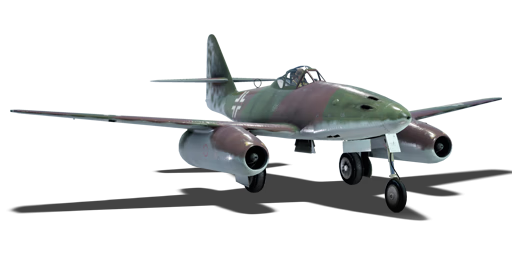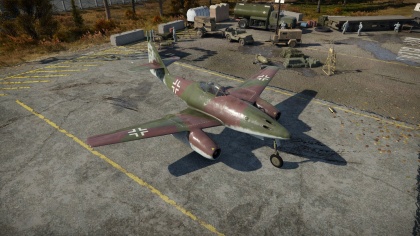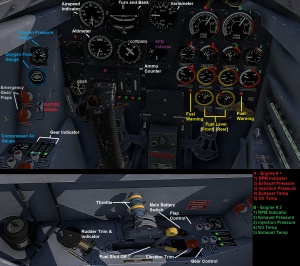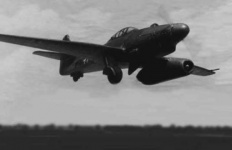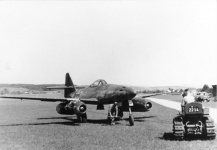Me 262 A-1a
Contents
| This page is about the German jet fighter Me 262 A-1a. For other uses, see Me 262 (Family). |
Description
The Me 262 A-1a Schwalbe is a rank V German jet fighter
with a battle rating of 7.3 (AB) and 7.0 (RB/SB). This jet fighter has been in the game since the start of the Open Beta Test prior to Update 1.27.
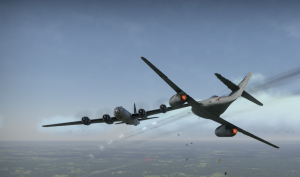
This aircraft is a true heavy fighter in every way. Thus, the following is guaranteed: bomber "box formations" fall apart under your heavy rocket bombardments, flying fortresses perish within seconds by this machine's mighty claws, and the unusually low velocity of the German "sledgehammer" MK 108 cannons this aircraft wields will probably drive you insane.
The MK 108 has insane damage potential. With the second greatest in-game burst mass of 14.52 kg/s (32.01 lbs/s) and the great explosive warhead "Minengeschoss" (mine-shell), this weapon will vaporize aircraft, especially bombers. But every coin has a flip side and the "Sledgehammer" is no exception. The amazing rate of fire is exchanged with a very short barrel and small propellant charges, resulting in very bad ballistics. The MK 108 cannon fires the slowest shells with the greatest bullet drop in the game. Thus, the MK 108 makes no compromises, only excelling in the "extremes".
As you might guess, the MK 108 is a very bad anti-fighter weapon particularly in a jet to jet combat. Bullet drop and slow velocity result in a severe difficulty leading shots at ranges above 300 meters (350 yds). In dogfights where both aircraft are constantly turning and changing direction, this trait gets even worse. The high speeds of jet battle push the necessary lead for hitting the target farther in front of the enemy. Training with this weapon system in a custom battle against random enemies is heavily advised.
The MK 108 cannons have an ammo indicator in the cockpit, which is typical for Luftwaffe aircraft. It sits directly beneath the compass (the one with the little plane in the middle). The left white column is for the two top auto-cannons. The right one is for the bottom two cannons; this bar is also taller than the left one as the ammo count is different for the two pairs.
General info
Flight performance
Describe how the aircraft behaves in the air. Speed, manoeuvrability, acceleration and allowable loads - these are the most important characteristics of the vehicle.
| Characteristics | Max Speed (km/h at 6,000 m) |
Max altitude (metres) |
Turn time (seconds) |
Rate of climb (metres/second) |
Take-off run (metres) | |||
|---|---|---|---|---|---|---|---|---|
| AB | RB | AB | RB | AB | RB | |||
| Stock | 824 | 798 | 12500 | 29.0 | 30.0 | 16.0 | 15.0 | 750 |
| Upgraded | 909 | 865 | 27.7 | 28.0 | 24.5 | 20.0 | ||
Details
| Features | |||||
|---|---|---|---|---|---|
| Combat flaps | Take-off flaps | Landing flaps | Air brakes | Arrestor gear | Drogue chute |
| ✓ | ✓ | ✓ | X | X | X |
| Limits | ||||||
|---|---|---|---|---|---|---|
| Wings (km/h) | Gear (km/h) | Flaps (km/h) | Max Static G | |||
| Combat | Take-off | Landing | + | - | ||
| 1050 | 450 | 580 | 580 | 380 | ~11 | ~5 |
| Optimal velocities (km/h) | |||
|---|---|---|---|
| Ailerons | Rudder | Elevators | Radiator |
| < 500 | < 600 | < 680 | N/A |
Engine performance
| Engine | Aircraft mass | |||||||
|---|---|---|---|---|---|---|---|---|
| Engine name | Number | Empty mass | Wing loading (full fuel) | |||||
| Junkers Jumo 004B-1 | 2 | 4,280 kg | 287 kg/m2 | |||||
| Engine characteristics | Mass with fuel (no weapons load) | Max Takeoff Weight | ||||||
| Weight (each) | Type | 16m fuel | 20m fuel | 30m fuel | 45m fuel | 53m fuel | ||
| 720 kg | Axial-flow turbojet | 4,894 kg | 5,041 kg | 5,409 kg | 5,961 kg | 6,255 kg | 6,520 kg | |
| Maximum engine thrust @ 0 m (RB / SB) | Thrust to weight ratio @ 0 m (100%) | |||||||
| Condition | 100% | WEP | 16m fuel | 20m fuel | 30m fuel | 45m fuel | 53m fuel | MTOW |
| Stationary | 910 kgf | N/A | 0.37 | 0.36 | 0.34 | 0.30 | 0.29 | 0.28 |
| Optimal | 910 kgf (0 km/h) |
N/A | 0.37 | 0.36 | 0.34 | 0.30 | 0.29 | 0.28 |
Survivability and armour
- 15 mm Steel - Behind the pilot
- 15 mm Steel - Pilot's headrest
- 15 mm Steel - Between cockpit and fore fuel tank
- 15 mm Steel - Instrument panel plate
- 16 mm Steel x 2 - Ammunition protection plates
- 90 mm Bulletproof glass
Modifications and economy
Armaments
Offensive armament
The Me 262 A-1a is armed with:
- 4 x 30 mm MK 108 cannons (2 x 100 RPG top + 2 x 80 RPG bottom = 360 total)
All four cannons are arranged in bundles of two mounted on the underside of the upper mounted in the nose of the aircraft. Two are outfitted with 100 RPG, while the other two have 30 RPG.
Suspended armament
The Me 262 A-1a can externally outfit:
- 24 x 55 mm R4M rockets
- 48 x 55 mm R4M rockets
Usage in battles
As a heavy fighter, the 'Schwalbe' is not nimble, but neither are other first-generation jets. Compared to them, the Me 262 is actually quite agile and possesses a speed, roll, and damage output advantage against certain adversaries.
However, don't be fooled - this aircraft was the first operational jet fighter. Generally, anything 3 years older than the 262 outclasses it. Against them, the 262's turn rate is your only advantage, with the exclusion of the Gloster Meteor. Avoid combat with Meteors if possible, however, if engaged with a Sea Meteor or any later variant, do not attempt to dive as it will only make your situation worse. Try alternating barrel rolls to force them to overshoot. Joystick users can try the classic trick of banking the aircraft about 120-180 degrees out of phase of the enemy aircraft with a positive G-load but as usual, they will need to watch their altitude carefully.
The 'Schwalbe' climb rate is actually not too bad as stock in 6.0-7.0 games but to climb well you need to be around 450 to 500 km/h for best climb rate which can be visually unappealing due to its low angle of climb. This in itself can be used to out-run and climb simultaneously as an advantage.
The Schwalbe has three main possible usages:
- Air-supremacy-fighter:
Find and destroy other fighters. While the historic purpose of the Me 262 was a bomber interceptor, it performs well against other fighters. However, it must be played like a heavy fighter or, for instance, the Fw 190 series. Be careful and plan every step ahead, including your retreat and how you will regain lost energy. A standard attack looks like the following:
- Find a target already engaged in combat and busy or an enemy who is alone.
- Position yourself with either a speed or energy advantage in the enemy's blind-spot (where they would least expect you, attacking with the sun behind you is a good tactic).
- Proceed closer to the enemy aircraft with the energy advantage you hold.
- Launch a deadly surprise attack.
- Escape any other nearby enemies with a "zoom climb" or a continuation of the approach at your maximum speed.
- Once enough separation has been gained (3-5 km), regain energy by accelerating or climbing. Likewise, engaging a different target who has lower energy is an option.
These tactics are virtually the same as used by the Fw 190 series and also works on all early jets (Meteor F 3, P-80, MiG-9, F2H, Kikka, R2Y2), etc.
Against later jets, (Sea Meteor, La-15, F9F), it gets trickier as they can easily neglect any energy advantage you built up due to their superior acceleration. The approach suggested above will still work, but needs to be executed with even more caution. Having allies nearby to assist is also often mandatory in matches like these, as a single 262 bears little threat to Korean War jets.
Against these superior foes, one of the 262's lesser strengths can be used - the turn rate. For a few turns, the Schwalbe will easily outmanoeuvre most Korean War jets, apart from the naval carrier jets like the F9F Panther and Seameteor.
- Bomber interceptor:
History's call. Seek and annihilate any heavy bombers with the impressive armament the Me 262 brings to the battlefield. Avoid getting shot at though! The 262's engines are weak and like to burn. If the engines catch on fire, throttle down and then shut off the engine (default "i") and go into a dive to gain speed. Rockets are also fun in this mode, as the Schwalbe has the option to carry up to 48 55 mm R4M rockets. Don't forget to set a detonation timer for the R4M missiles so they do not require direct hits. 600-800 meters is suggested.
- Ground attacker:
Bad acceleration and a high stall speed - usually not the traits wielded by an attacker, but the Schwalbe as two very convincing arguments on its side: R4M rockets and bad matchmaking. The 24 (48 seconds unlock) rockets can destroy light pillboxes, medium tanks and mini bases (~50 rocket impacts). Peculiar to note is the ability of the MK 108 to destroy light pillboxes. 60-80 shots are needed from a very low angle and from a short distance. Also, the Me 262 can get dragged up to games where it will face Korean War jets. One could try, as an experienced pilot, to get the best out of the situation. Those who are not as skilled at ground attacking still benefit the team; if the match starts to take longer, a ground victory becomes a viable option. The same applies if the last enemy is hiding and the tickets start to count down.
Going against other countries would bring out their jets. Other countries' first-generation jets include the F-80A-5, Meteor Mk. 3, Vampire, MiG-9, Kikka and Yak-15. The Me 262 is the heaviest of them and thus reigns straight line kinetic energy retention at high speeds.
- Top speed goes to the F-80, followed by the MiG-9 and Meteor F.4. Not all is grim though! Both the Vampire and Yak-15 sit far at the end of the spectrum.
- The Sea Meteor has the best acceleration in the horizontal, although it will break apart before it can reach its top speed. In the vertical, however, the weight and design of the Me 262 allow for the most rapid dive in this time era.
- Turn rate: Do not turn in jets!, or heavy fighters like in this case. Pure horizontal manoeuvres are reserved for emergency situations and should be avoided accordingly.
As such, the Me 262 is often lacking in certain traits compared to its BR contemporaries. Always try to get a drop on the opponent and catch them by surprise rather than a straight-up dogfight.
Manual Engine Control
| MEC elements | ||||||
|---|---|---|---|---|---|---|
| Mixer | Pitch | Radiator | Supercharger | Turbocharger | ||
| Oil | Water | Type | ||||
| Not controllable | Not controllable | Not controllable | Not controllable | Separate | Not controllable | Not controllable |
Modules
| Tier | Flight performance | Survivability | Weaponry |
|---|---|---|---|
| I | Fuselage Repair | R1 Modifications | |
| II | Compressor | Airframe | Offensive 30 mm |
| III | Wing Repair | R1/II Modifications | |
| IV | Engine | Cover | New 30 mm Cannons |
The biggest issue of the Schwalbe is its bad acceleration across all speeds. Thus, Compressor and Engine upgrades have the highest priority. The cannons' stock belts are decent, but the high explosive content increases with the new ammo in Offensive 30 mm. Including them into the upgrade route is not a bad idea. The same applies for the rockets in the R1 modification. Being able to knock out bases (~40) or tanks (direct hit) with these warheads makes a long game much easier to win. New 30 mm cannons is an interesting upgrade choice as it increases accuracy above 300 meters (350 yds), but the MK 108 will still be unable to hit any at 500 meters (600 yds).
Pros and cons
Pros:
- Heavy armament, third-highest one-second burst mass of any aircraft in the game
- Hard-Hitting shells destroy fighters in one or two hits and B-29s also only require about 3 hits
- Decent energy retention (compared to other 7.0 battle rated aircraft)
- Good payload against medium tanks, bases, and light pillboxes
- Good roll rate at low speeds
- Fairly manoeuvrable at low speeds compared to other early jets
Cons:
- Rather slow compared to most other jets
- Bad acceleration and poor turn rate
- As with most Me 262's, the take-off run is relatively long
- Poor rate of climb (important if you want to intercept B-29s)
- Not very nimble at high speeds
- Awful guns for jet-to-jet combat ("snapshots" are possible, but very difficult)
- 30 mm cannons have very small ammo count, requires trigger discipline
- Cannons have a wide spread
- Tends to "flip about" after doing vertical manoeuvres
- Unusually high wing angle of attack is required for level flight at most speed ranges so aircraft tends to bleed energy easier when turning
- Fuel feed cuts off if flying with inverted G-loads for an extended period of time
- Very exposed engines that are very susceptible to damage
History
Describe the history of the creation and combat usage of the aircraft in more detail than in the introduction. If the historical reference turns out to be too long, take it to a separate article, taking a link to the article about the vehicle and adding a block "/ History" (example: https://wiki.warthunder.com/(Vehicle-name)/History) and add a link to it here using the main template. Be sure to reference text and sources by using <ref>, as well as adding them at the end of the article. This section may also include the vehicle's dev blog entry (if applicable) and the in-game encyclopedia description (under === In-game description ===, also if applicable).
In-game description
"The Messerschmitt Me 262 was a German jet fighter, fast bomber and reconnaissance aircraft of the WWII era. It was the world's first mass-produced jet fighter and the first jet aircraft to see combat. The first serial variant, the Me 262 A-1a, unofficially known as 'Schwalbe', arrived for flight testing in Lechfeld in July 1944. The construction used generic alloys, was almost fully riveted and its weight was rather high, all for the sake of ease of mass production. The Jumo 004B-1 jet engine (later B-2 and B-3) also housed a 2-stroke Riedel motorcycle engine, used as a starter. Two small 17-liter fuel tanks were used to power the starter. The rest of the fuel was housed in the fuselage. Two main and two extra fuel tanks were used. Main tanks held 900 liters of fuel, the nose tank had 170 liters and the rear tank held 600 liters.
Radio equipment included the FuG 16ZY radio (later replaced with the FuG 15) and the FuG 25a IFF set. The 262 was armed with four 30mm MK 108 cannon with 100 rounds per gun for the top pair and 80 rounds per gun for the bottom pair. The pilot was protected by a 90mm armored glass and 15mm armored plating on the sides and back.
The Me 262 A-1 was easier to fly than the Bf 109G. Considering the great range of available airspeeds, the cockpit equipment was rather sparse. Although the turn radius for the jet fighter was significantly wider than that of a piston fighter, it could better retain high speeds in a turn. Its acceleration was much worse than that of a piston plane, but the Me 262 had an incredible dive rate, which could occasionally threaten going past Mach 1."
Media
- Skins
- Images
- Videos
See also
Links to the articles on the War Thunder Wiki that you think will be useful for the reader, for example:
- reference to the series of the aircraft;
- links to approximate analogues of other nations and research trees.
External links
Paste links to sources and external resources, such as:
- topic on the official game forum;
- encyclopedia page on the aircraft;
- other literature.
| Germany jet aircraft | |
|---|---|
| |
Luftwaffe |
| He 162 | He 162 A-1 · He 162 A-2 |
| Me 163 | Me 163 B · Me 163 B-0 |
| Ho 229 | Ho 229 V3 |
| Ar 234 | Ar 234 B-2 · Ar 234 C-3 |
| Me 262 | Me 262 A-1a · Me 262 A-1a/Jabo · Me 262 A-1a/U1 · Me 262 A-1/U4 · Me 262 A-2a |
| Me 262 C-1a · Me 262 C-2b | |
| |
LSK |
| Fighters | ◊MiG-15bis · ◊Lim-5P · ◊MiG-19S |
| ◊MiG-21MF · ◊MiG-21bis-SAU · ◊MiG-21 "Lazur-M" | |
| ◊MiG-29 | |
| Attackers | ◊MiG-23BN · ◊MiG-23MF · ◊MiG-23MLA |
| ◊Su-22UM3K · ◊Su-22M4 | |
| ◊IL-28 | |
| |
Luftwaffe |
| F-84 | ◄F-84F |
| F-86 | ◄CL-13A Mk 5 · ◄CL-13B Mk.6 · ◄F-86K |
| F-104 | ◄F-104G |
| F-4 | ◄F-4F Early · ◄F-4F · ◄F-4F KWS LV |
| G.91 | ◄G.91 R/3 · ◄G.91 R/4 |
| Tornado | ◄Tornado IDS WTD61 · ◄Tornado IDS MFG · ◄Tornado IDS ASSTA1 |
| Other | Alpha Jet A · ◄Sea Hawk Mk.100 |
| Ex-LSK | ◄MiG-21 SPS-K · ◄MiG-29G · ◄Su-22M4 WTD61 |
| |
Swiss Air Force |
| ◌Hunter F.58 · FFA P-16 | |


